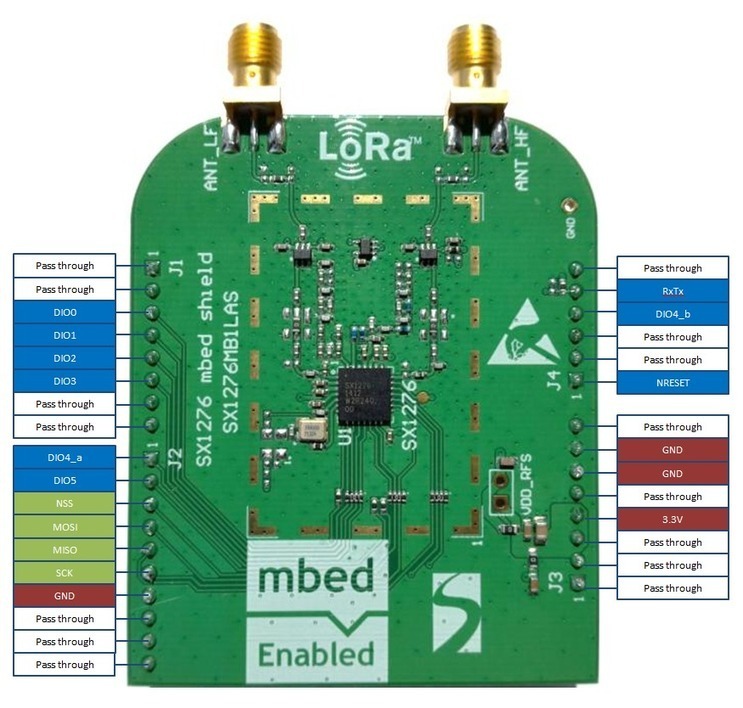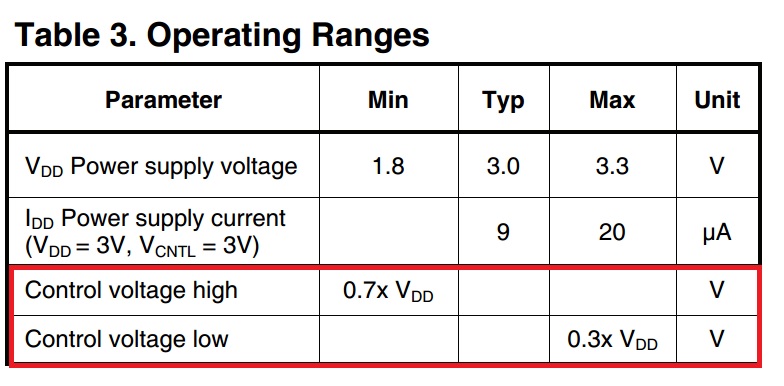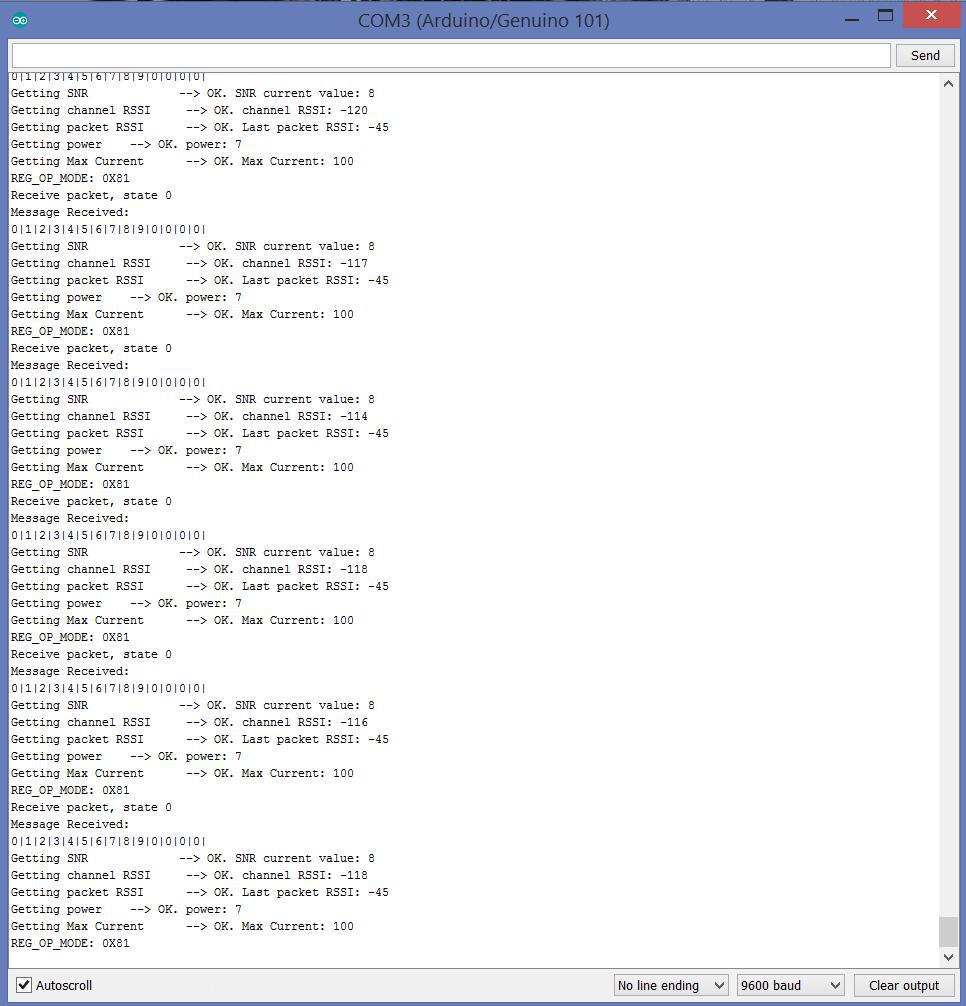Hi,
I have a problem with mbed LoRa boards(SX1276MB1MAS). I’m using Arduino 101 and mentioned board(node to node).
This is my settings:
output power: 14dbm
BW: 125KHz
SF: 10
Channel: 433MHz
and an antenna with 1/4 wave length, gain of 0.7dbi
I check the SX1276 Registers in transmitter and receiver and everything is ok.
but when this two device are near together in distance of 1cm i get a RSSI around -50 and SNR 8-10, and when i increase the distance to 1m, i see RSSI= -75 and SNR 6-8!
I’m really confused and expected higher ranges in LoRa! can anyone help me?
Its very difficult to make predictions for LoRa range\distance based on tests at such short distances.
Its probably not such a good idea to inject 14dBm of power into the receive antenna at a distance of 1cm !.
Not sure what effect or damage that might have on the receiver.
Have you connected the boards to The Thing Network ?
Thanks for answer.
No i didn’t, how can i use Things Network? should i use LMIC lib for this?
Do you have any suggestion lead me to solve the problem?
Is that possible the board has been damaged?
From experience,
You need at least a few meters distance between your two nodes for correct operation. 1cm is definitely much too close, even without antennas attached. You will probably find that you can receive your Lora sensor on multiple channels, with CRC errors in that case. So for example transmitting on channel 0 you can receive the packets on channel 1 with CRC errors.
You dont know if you have a problem or not, yet.
Close coupling TX and RX antennas like that at that power level would have exceeded the maximum ratings for the receiver, whether that actually damages the devices I am not inclined to test.
Where in the World are you ?
I have done it before, and did not get a properly result: -110 RSSI, -5 SNR at just 200m away LOS(2m higher than ground)
I’m from Iran sir.
In this forum you mentioned that you get 40KM range with just 3mW power consumption, i’d appreciate if you explain about your experience, what kind of module do you use? and where did you test it(environment condition)?
Thanks sir.
Thanks for answer.
I tested it before but i couldn’t get a good result as i mentioned: RSSI: -110, SNR: -5; 200m away and 2m height.
This range is disaster! and definitely there’s a problem in board or antenna. i have debug my code step by step even in library that i use and the registers set as they must be.
I looked at the module you are using. The SX1276MB1MAS has two RF paths. A 868MHz one and a 433MHz one. So you would need to use the ANT_LF antenna connector for your application to work at 433MHz.
It looks like you also have to drive the RXTX_EXT pin in order to switch from receive to transmit. But maybe you are already doing all that…?
Read about it here;
That was back in January 2015, the results surprised many at the time, but have been borne out by the recent 702km using LoRaWAN;
Perhaps what people find the hardest to understand is the huge difference there is between the range you get under line of sight conditions and in and around buildings, it can be as much as 1500:1.
In my experience the common reasons for very poor range are;
Damadged modules that have been used with no antenna connected.
Faulty antennas
No antenna connected, or connected to the wrong port.
Modules that include antenna switching not being configured correctly
Yes, i connected the antenna on ANT_LF.
And your second note, are u referring to RxTx pin at right top in pinout i attached?
It’s really wonderful! i can’t imagine 700KM! Thanks for this useful links, i’ll study this articles and focus on for points you mentioned. I will keep in touch with you.
Thank you so much
It is indeed pin 5 of connector J4, RxTx that you need to drive in order for the PE4259 RF switch to go from RX to TX.
It might affect. question is why i am receiving the signal without setting the RF_switch?
Because LoRa is good enough to receive packets without an antenna connected, but has the symptom (as mentioned above) of very poor range.
I looked at the datasheet for the two RF switches (U2 and U5) that sit on the board. (http://www.psemi.com/pdf/datasheets/pe4259ds.pdf)
The way I read it is as follows: when pin 4 (CTRL) of U2 is low the common RF input/output (pin 5 RFC) is connected to pin 3 (RF2). So when the RXTX pin is not driven it is permanently tied to ground via a resistor on the board. Thereby setting both RF switches U2 and U5 in receive mode.
If you want to transmit you will have to set RXTX high, transmit a LoRa message and switch back to receive.
In case you are not operating this pin it might explain your poor range. A simple test could be to tie the pin on the board that you are using as transmitter to +3.3V and on the receiver to GND.
Curious if that helps…
It’s not possible to supply a 3.3v via a wire but there is nothing about voltage limiting on control pin(HIGH) in switch datasheet and so i used arduino 5v to set control pin high for transmitter and down for receiver.
so now, in 433MHz and 7dbm i get RSSI: -45 and SNR: 7-9 in a room(2m distance)! difference is very much, is this result acceptable or not?

Looks like your receive values are about 30dBm (1000x) stronger than before. I can’t comment too much on the absolute values you are reporting, but compared to your earlier readings this looks much better to me. If both your modules where in receive mode, whereas one of them was transmitting, that will explain why your range was that bad.
I’m grateful for your help sir. i’ll keep testing in a higher and LOS environment. maybe a better antenna like 4.5dbi gain give better results. Thanks again 
By the way i decreased transmit power to 7dbm. it was 14dbm before.
Hi, You cannot meassure the RSSI in a short distance with a normal antenna and receiver. Because near the antenna there is not a normal frequency domain propagation, the magnetic field is bigger than the electrical field. This is known as near field.
The limit of near field in air can be calculed as 3·lambda (wavelength), that for 466 MHz is: 3·3·10 exp8 / 466·10 exp6 = 1.93 meters
Below this distance, the electrical field you receive is lower than the magnetic field, so a regular device cannot measure the RSSI properly.